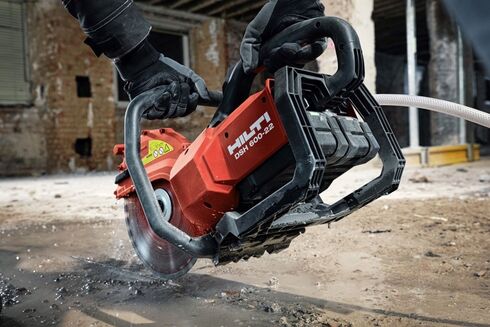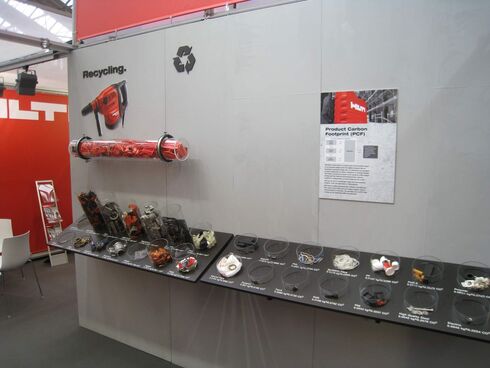
Hilti’s wider circle
11 April 2024

As followers of the blog will know, the issue of circularity and the wider circular economy is one of Hilti’s key areas of focus on its journey towards Net Zero.
The topic was described in blog posts like the recent one here, and it essentially emphasises the fact that carbon reduction should consider the whole lifecycle of a product, not just individual parameters. Reusing, repurposing and ultimately recycling the equipment will all need to be addressed.
So I was fascinated when the opportunity arose recently to visit Hilti's UK headquarters in Manchester to obtain an update on the latest initiatives in this important subject area.
Incidentally, it’s striking to recall just how long Hilti has emphasised the importance of sustainability. Indeed, I remember visiting the International Rental Exhibition in Amsterdam back in – goodness me – 2011, where the manufacturer’s stand (pictured below) highlighted the topic.
Back then, the company showed how the vast majority of components used in a Hilti TE-80 combi hammer could be completely recycled, from the plastic casing and metal components, to lubricants and batteries. Each different material making up the machine had been extracted and was displayed in individual containers on the stand display. And at the time, Hilti was already noticing interest from hirers who wanted to deal with suppliers who had comprehensive green policies.
Since then, of course, further progress has been made throughout the wider supply chain. At the end of 2023, the Hilti Group reached CO2 neutrality in its own operations, following criteria set under the Science Based Targets initiative (SBTi) and in 2021 the organisation achieved a Gold sustainability rating from the EcoVadis agency, putting it among the top 5% of all companies evaluated. The business is now working towards a Platinum rating, placing it in the top 1%.
Margaux Wibin, Hilti’s Sustainability Manager Great Britain - Northern Europe, told me that carbon neutrality was achieved in 2023 with a 60% reduction in Scope 1 and 2 emissions against a 2019 baseline, with 40% being offset. The aim is to reach a 90% decrease by 2050 but, before then, a further 30% reduction decoupled from economic growth compared with 2022 levels by 2032.
Furthermore, this positive experience is now leading to a wider focus beyond Hilti’s own operations to include customers and suppliers, offering support on their own Net Zero journeys.
Margaux pointed out that construction activity is responsible globally for some 37% of CO2 emissions and embedded carbon, and 50% of all materials extracted globally are used in construction, so by using sustainable products and solutions, considerable reductions can be made.
She said that Hilti has assigned a numerical Life Cycle Assessment (LCA) to almost every tool in its portfolio, including those on its latest Nuron cordless platform (pictured above). This encapsulates all elements of a product's lifecycle, from manufacture to end of life across all its components and supply chain elements.
Margaux said that, on average, 77% of a Hilti tool’s carbon footprint arises from the raw materials used, so emphasis is placed on reducing this, perhaps by using recycled elements, and often working closely with other suppliers and hire partners to discuss changes and enhancements.
Improving a product’s performance to weight ratio is also highlighted, reducing material usage while maintaining or improving productivity, as well as potentially delivering Health & Safety benefits.
Data like this can help hirers and end users in determining their own carbon footprints. However, Walid Hussain, Hilti GB’s National Tool Hire Manager (UK), said that sustainability is more than quoting numbers.
“It is an ongoing process and we all have a responsibility to reduce carbon in other ways. For example, how many tools throughout industry are scrapped or, even, disposed of in landfill in unsatisfactory ways? By extending the life of equipment, we can increase product sustainability and reduce lifetime costs.”
Walid cited the example of Hilti’s central service and repair centre in Glasgow which can keep tools in optimum condition efficiently. He added that, under the manufacturer’s Fleet Management service where customers pay a fixed monthly charge for a tool together with maintenance, economic benefits can rise significantly in subsequent years of the agreement, helping to maintain sensible hire rates.
Components beyond their useful or economic life can be reused, repurposed or, as a last resort, recycled to again maximise circularity.
Margaux added that the charitable Hilti Foundation can make reconditioned tools available for worthy projects and good causes throughout the world. This helps communities and, on the way, furthers Hilti’s CSR (corporate social responsibility).
Moreover, Walid said that, as well as providing data on tools' carbon footprints, Hilti can partner with customers to make further reductions. This might include looking at a company’s existing fleet and seeing if savings can be made – perhaps streamlining the variety of different breaker models offered, say, or the number of battery chargers provided – and assessing overall tool requirements.
He added that more construction companies are exploring sustainable ways of working and that the focus will increase on sub-contractor and smaller businesses in the future as they area asked to supply carbon data in tender processes.
“This sees Hilti transitioning from a supplier of tools to a service provider, and delivering solutions to protect the planet,” said Walid.


